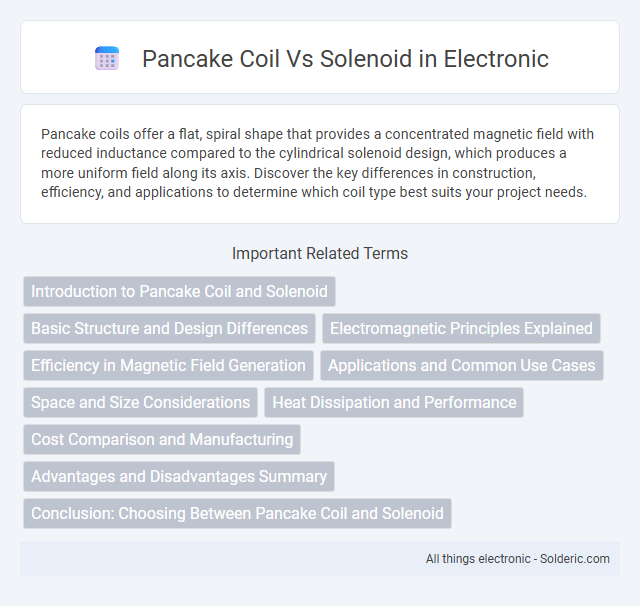Pancake coils offer a flat, spiral shape that provides a concentrated magnetic field with reduced inductance compared to the cylindrical solenoid design, which produces a more uniform field along its axis. Discover the key differences in construction, efficiency, and applications to determine which coil type best suits your project needs.
Comparison Table
| Feature | Pancake Coil | Solenoid |
|---|---|---|
| Shape | Flat, spiral winding | Cylindrical, helical winding |
| Magnetic Field | Broad, uniform field along plane | Strong, concentrated field inside coil |
| Applications | Inductive charging, sensors, RF circuits | Electromagnets, actuators, valves |
| Size | Compact, low profile | Longer, cylindrical form |
| Inductance | Lower inductance for given turns | Higher inductance per unit length |
| Construction Complexity | Simple flat winding | More layers, 3D winding |
| Heat Dissipation | Better surface area, cooler operation | Less surface area, potential hot spots |
| Magnetic Field Direction | Mostly perpendicular to coil plane | Parallel to coil axis |
Introduction to Pancake Coil and Solenoid
Pancake coils are flat, spiral-shaped electromagnets designed to generate a concentrated magnetic field over a small area, commonly used in wireless power transfer and magnetic resonance imaging (MRI). Solenoids consist of helical wire windings that create a uniform magnetic field inside a cylindrical coil, widely applied in electromechanical devices such as valves and actuators. Both coil types optimize magnetic field generation but differ in geometry and field distribution to suit specific industrial and medical applications.
Basic Structure and Design Differences
Pancake coils feature a flat, spiral winding pattern with a single or few layered turns, optimizing for a low-profile and wide surface area, while solenoids are cylindrical and consist of tightly wound helical coils around a core. The pancake coil design allows for efficient magnetic field distribution perpendicular to the coil plane, whereas solenoids generate a magnetic field along the axis of the cylinder. These structural differences influence their respective applications, with pancake coils suited for planar magnetic coupling and solenoids for producing uniform magnetic fields in linear actuators and inductors.
Electromagnetic Principles Explained
Pancake coils generate a magnetic field primarily in a flat, disc-shaped area, producing a concentrated, planar electromagnetic flux ideal for applications requiring precise field direction. Solenoid coils create a magnetic field along the axis of a cylindrical coil, resulting in a uniform and strong magnetic flux over a longer distance, suitable for linear actuation or inductance purposes. Understanding these electromagnetic principles can help you select the right coil design for efficient energy transfer and optimal magnetic field control.
Efficiency in Magnetic Field Generation
Pancake coils produce a highly uniform magnetic field over a flat, wide area, making them efficient for applications requiring precise field distribution. Solenoids generate stronger magnetic fields along their axial length, offering greater field intensity useful for penetrating deeper into materials. Your choice depends on whether uniformity or field strength is the priority in your magnetic field generation needs.
Applications and Common Use Cases
Pancake coils are typically used in applications requiring a flat, compact magnetic field, such as wireless charging pads, inductive heating systems, and precision sensors. Solenoids are commonly found in electromagnetic actuators, valve control systems, and mechanical relays where a linear magnetic force is needed. Your choice depends on whether you require a localized planar magnetic field or a strong, linear electromagnetic force for your specific project needs.
Space and Size Considerations
Pancake coils offer a flat, compact design ideal for applications with strict space constraints, enabling efficient use of surface area without sacrificing magnetic field strength. Solenoids, while generally longer and cylindrical, provide a more uniform magnetic field along their axis but require more axial space, making them less suitable for low-profile installations. Your choice between the two should consider the available installation space and the desired magnetic field characteristics to optimize performance within size limitations.
Heat Dissipation and Performance
Pancake coils offer superior heat dissipation due to their flat, wide design which allows for a larger surface area in contact with cooling elements, enhancing thermal management during high-power applications. Solenoids, while compact and efficient for creating uniform magnetic fields, tend to retain more heat internally because of their tightly wound cylindrical structure, potentially impacting long-term performance. Understanding these heat dissipation characteristics helps optimize your choice based on the thermal and electromagnetic performance requirements of your specific application.
Cost Comparison and Manufacturing
Pancake coils generally incur higher manufacturing costs due to their complex winding process and precise flat geometry compared to solenoids, which benefit from simpler cylindrical winding techniques and widespread production. The cost difference impacts applications where budget constraints prioritize solenoids for their efficiency in mass manufacturing and ease of automation. Your decision between pancake coils and solenoids should consider the trade-off between manufacturing expenses and the specific electromagnetic performance required.
Advantages and Disadvantages Summary
Pancake coils offer a compact design with a wide magnetic field distribution, making them ideal for applications requiring uniform magnetic fields and efficient heat dissipation. Solenoids provide strong, concentrated magnetic fields with straightforward construction, but they tend to be bulkier and may generate more heat during continuous operation. Your choice depends on whether you prioritize field uniformity and cooling (pancake coil) or magnetic strength and simplicity (solenoid).
Conclusion: Choosing Between Pancake Coil and Solenoid
Choosing between a pancake coil and a solenoid depends on your application's space constraints and magnetic field requirements. Pancake coils offer a flat design ideal for compact spaces and generate a wide, uniform magnetic field, while solenoids provide a strong, focused magnetic field along their axis, suitable for linear motion or actuation. Consider your device's shape, required magnetic force, and efficiency to select the best coil type for optimal performance.
Pancake Coil vs Solenoid Infographic

 solderic.com
solderic.com